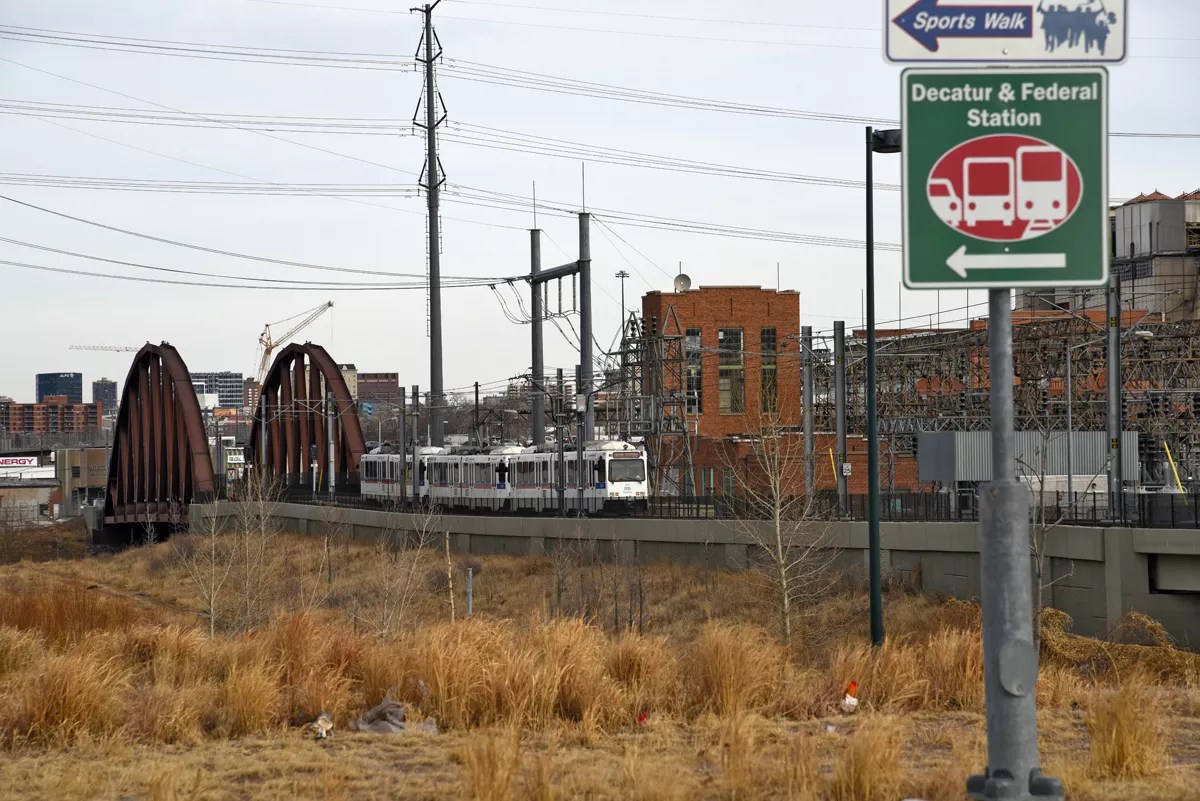
Anthony Camera

Audio By Carbonatix
One of Denver’s poorest neighborhoods is about to undergo a renaissance that could see it become a cultural and entertainment hub in the heart of the city over the next decade. Developers are poised to build on an established, if unofficial, recreational district in and around Sun Valley, which stretches from Interstate 25 on the east to Federal Boulevard on the west, Sixth Avenue on the south to 20th Avenue on the north.
Attractions in the neighborhood already include the Children’s Museum of Denver, the Downtown Aquarium and Elitch Gardens Theme and Water Park. Mile High Stadium and the Pepsi Center, which both host concerts as well as sporting events, are nearby; each has plans in the works to develop more projects on their own parking lots…if they don’t become a second headquarters for Amazon, one of the rumored sites included in Colorado’s bid. The Platte River Greenway runs through the area; over the past thirty years, it’s turned from a dumping ground into a regional amenity, pushing up real estate values. Light rail has also enhanced Sun Valley’s desirability; the West Line opened in 2013, connecting the neighborhood to downtown Denver, Lakewood and Golden.
While many city boosters thought that Arapahoe Square, located between 20th Street and Park Avenue West and Larimer and Glenarm streets, would be the next area to see a major influx of development, it turns out that Sun Valley – despite its disconnected street grid and both a highway and river cutting it off from downtown – is the spot where some developers see the most potential.
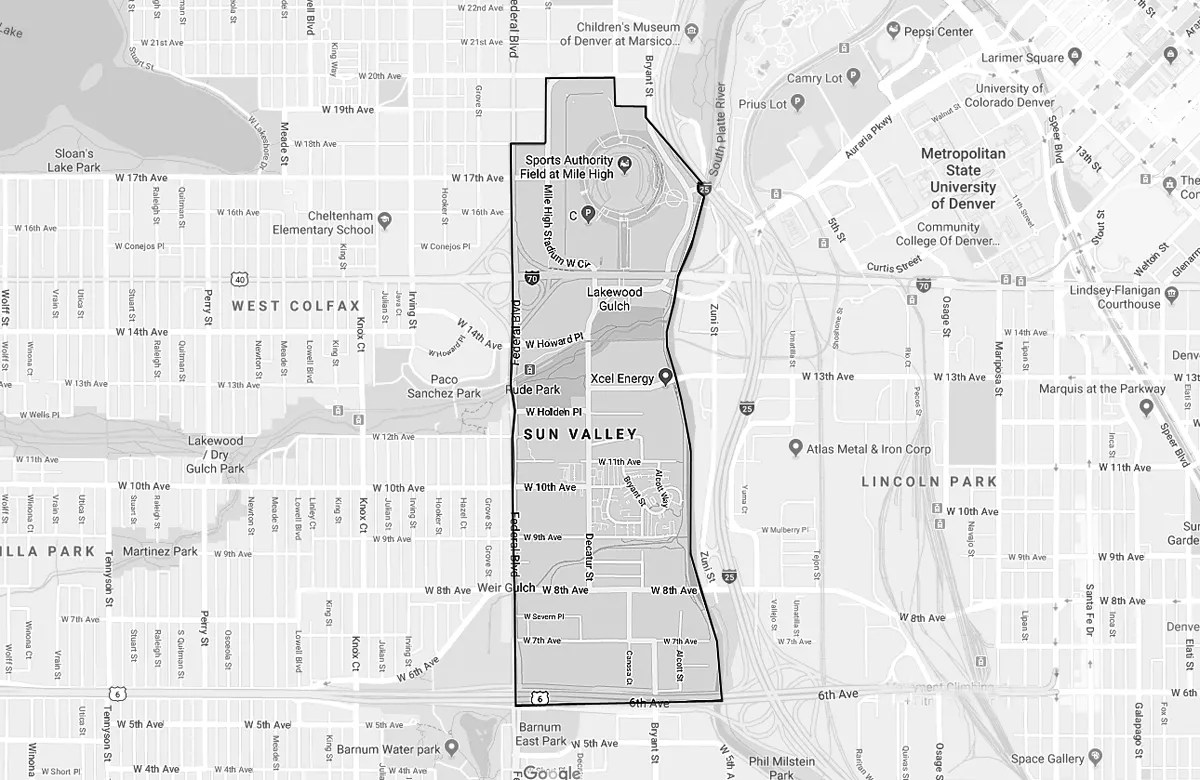
maps.denver.com
“Arapahoe Square is highly developable, but the land-ownership issues there make it difficult to assemble properties,” says architect Chris Shears, who is working on several sites in and around Sun Valley. “I really see Elitch’s and the Broncos’ properties developing more quickly because they’re under one ownership and one plan under one vision. All of these projects will feed on each other. Each of them have transit stations. There’s a connection to downtown with those stations.”
Although Sun Valley is one of the most geographically central neighborhoods in Denver, it’s also home to some of the city’s most vulnerable residents. The median annual income is just $9,874; 83 percent of Sun Valley households live below the poverty line. Despite Denver’s low unemployment rate of 3.1 percent, 70 percent of Sun Valley residents are without jobs. And the neighborhood’s violent-crime rate is the highest in Denver – 5.6 times the citywide average.
Despite these challenges, new investments are being made in Sun Valley that will transform what has historically been a largely industrial neighborhood into a family-oriented arts and entertainment district. But will the families that already live in Sun Valley still be around to enjoy it?
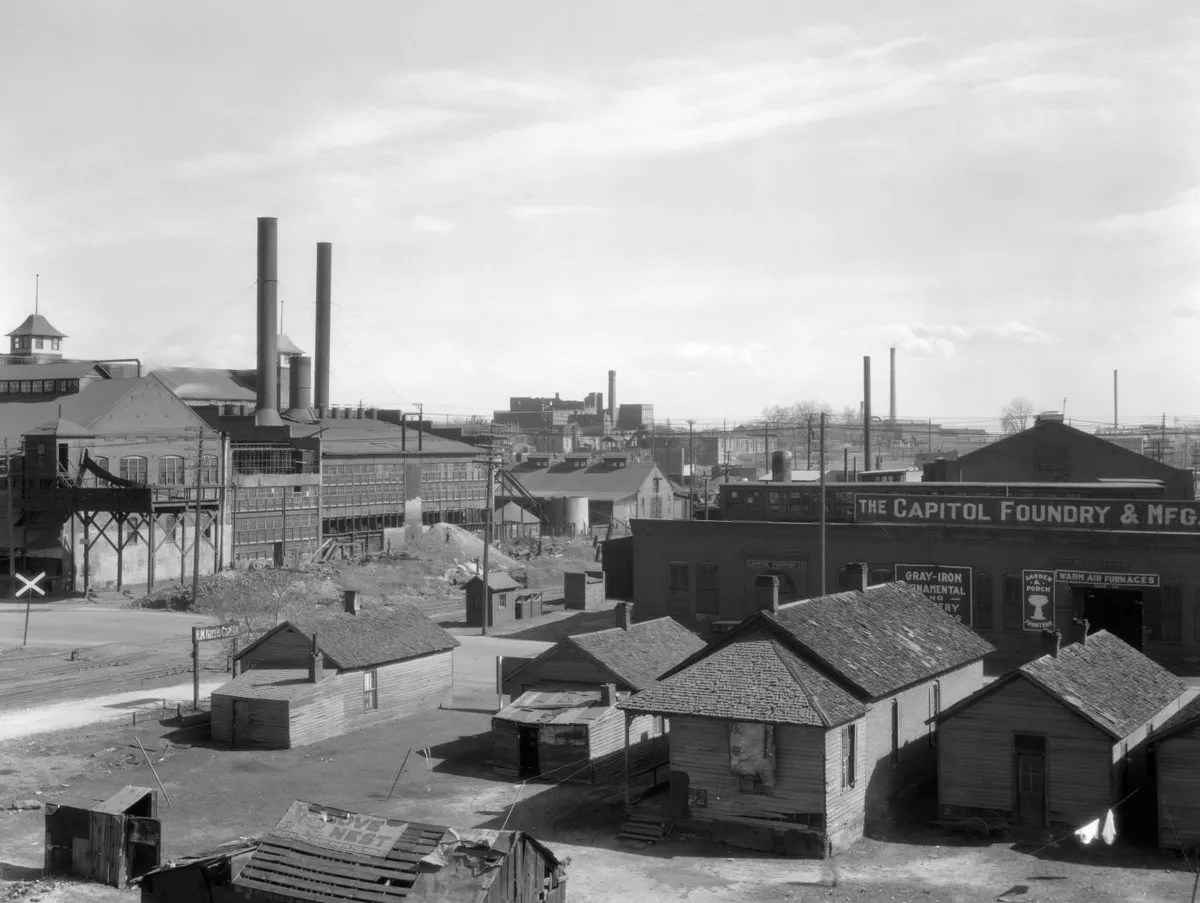
Sun Valley was zoned industrial in the ’20s.
Denver Public Library
When Jewish immigrants settled in Sun Valley in the late 1880s, Colfax Avenue – which was also known as the Golden Road – delineated the border of the then-booming community. The area to the south was filled with small homes and businesses, including both factories and farms. Sun Valley had a school, a synagogue, markets, a smokehouse, a bakery, a recreation center and a fishmonger, as well as a brick factory, a pickle factory, a rag shop and a power plant. In 1917, a viaduct for cars and streetcars was constructed above Colfax, connecting downtown Denver and the westside neighborhoods. In the 1920s, when the City of Denver passed its first zoning code, it designated Sun Valley, particularly the area around the South Platte River, as an industrial zone.
The area’s first public-housing project, Las Casitas, opened in 1942; it included 184 units that rented for $2.44 a room per month. Six years later, the Denver Bears Stadium was built just north of Colfax; it was replaced with the new, taxpayer-funded Mile High Stadium in 2001. In the 1950s, the construction of Interstate 25, then known as the Valley Highway, and the Colfax/Federal interchange resulted in the demolition of dozens of small, single-family homes. That same decade, Sun Valley Homes, a 330-unit, barracks-style affordable-housing complex, was added to the area.
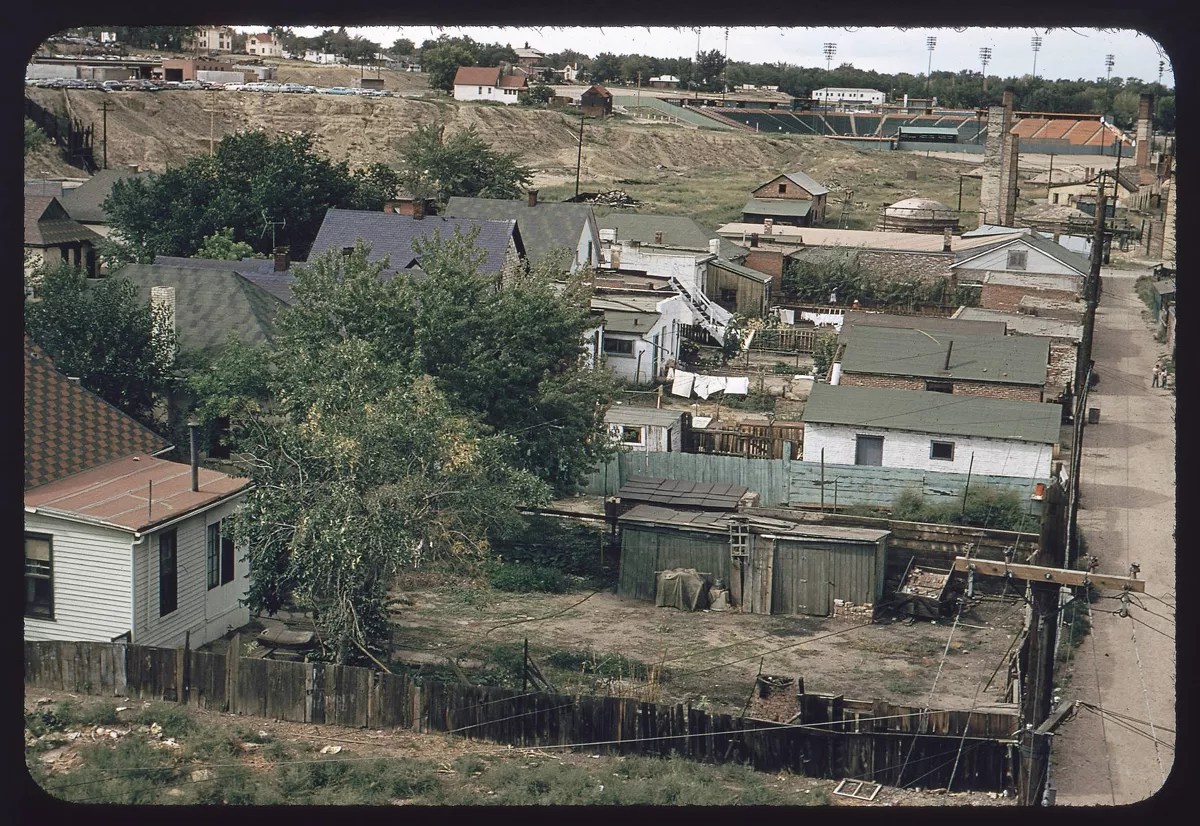
Houses were cleared for Bears Stadium.
Denver Public Library
In 1974, the Greenway Foundation was formed to change the South Platte River from a cesspool into a place of civic pride. Since then, the foundation has built more than a hundred miles of hiking and biking trails and created more than twenty parks and natural areas, including the South Platte Trail and Lakeview Gulch Trail in Sun Valley.
In recent years, Sun Valley’s location on the South Platte, its proximity to downtown and easy access to light rail have drawn the interest of developers, who recognize that the area could attract residents, businesses and cultural institutions alike. Denver created the Decatur Federal Station Area Plan in 2013 to establish a long-range vision and guiding principles for the development of the area surrounding the light-rail station, which includes virtually all of Sun Valley.
“The influence of riverfront revitalization is expanding north and south from its origins at Confluence Park. Sun Valley is at the heart of this revitalization,” according to the plan. “For the Sun Valley neighborhood, this transformation couldn’t be more welcome.”
That vision is starting to take root. Already, an old warehouse building has been redeveloped into an office complex known as Steam on the Platte, and last month Meow Wolf, a ten-year-old collective based in Santa Fe, announced that in 2020 it will open a 50,000-square-foot immersive art exhibit in a new five-story building sandwiched into a tangle of viaducts.
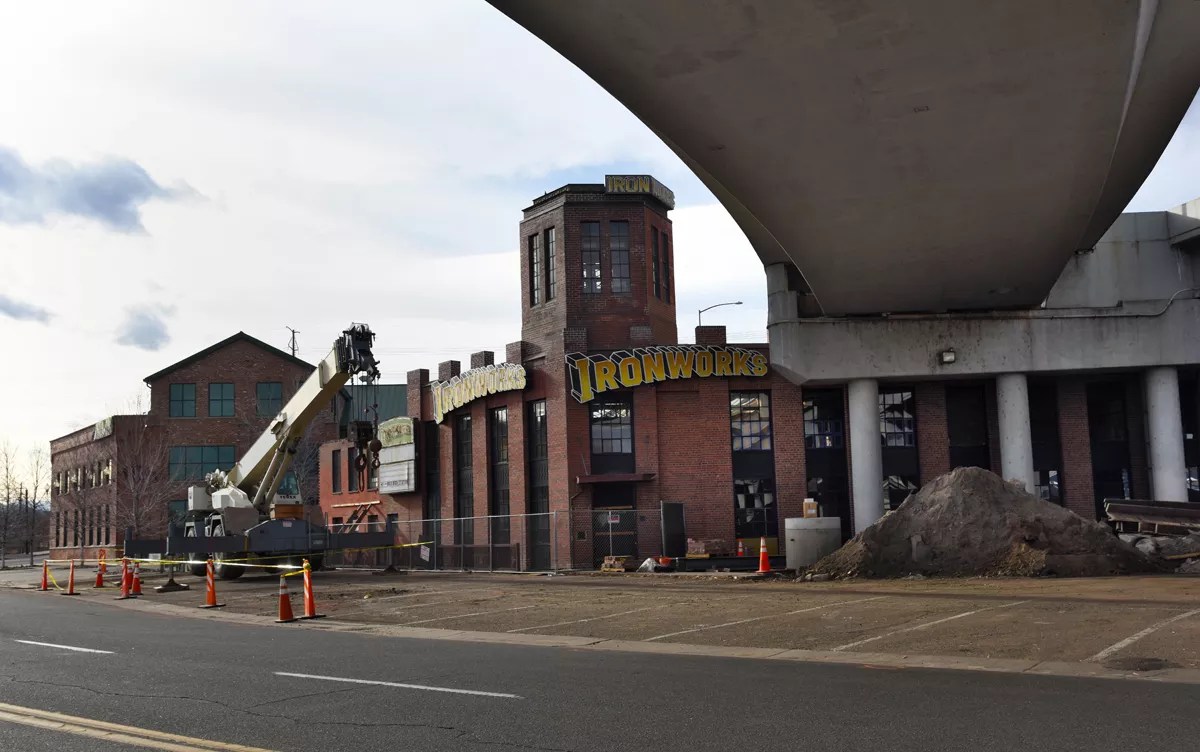
Meow Wolf will be built in the shadow of the Colfax Viaduct.
Anthony Camera
Members of Meow Wolf, which opened House of Eternal Return, a 20,000-square-foot immersive experience in Santa Fe, two years ago to immediate acclaim, had scoured the country looking for the right place to open a second installation, studying cities such as Austin, Minneapolis, Los Angeles and Washington, D.C., before deciding on Denver. “The momentum in Denver was positive and clear,” Meow Wolf co-founder and chief executive Vince Kadlubek said at the January 4 announcement. “Developers, landlords and artists wanted to work with us.”
Meow Wolf had looked at a number of locations in Denver, including the Sports Castle on Broadway and the old Denver Post printing plant off of Interstate 70. It even considered Idaho Springs, but Kadlubek said the potential for wildfires made him nervous. So did the traffic, which he described as both “interesting” and a “deterrent.” “The community of Idaho Springs was so nice and so welcoming,” he said. “I kind of fell in love with that town.
I’m interested in doing an outdoor activity thing, but unfortunately, we have to focus on the big thing first.”
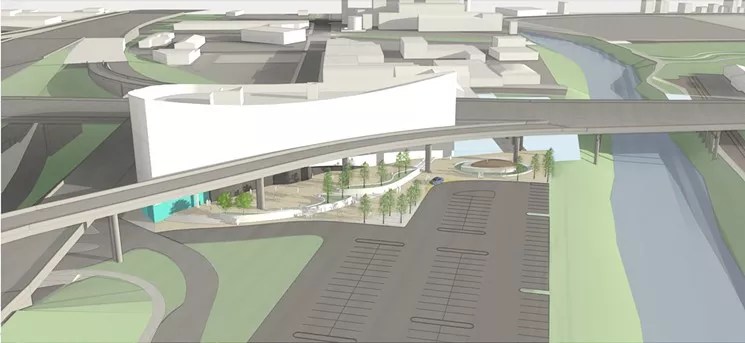
The future Meow Wolf, from the Auraria Parkway.
Shears Adkins Rockmore Architects
Ultimately, the site for the big thing came down to the River North neighborhood and Sun Valley. Though he liked RiNo overall, Kadlubek said that he didn’t feel Meow Wolf would be a good fit for the area, with its high concentration of residences; the group didn’t want Meow Wolf Denver to have an adverse impact on whatever neighborhood was selected.
“When I’m standing at a potential development site in RiNo and all I’m seeing is houses, I’m wondering what 1.5 million visitors a year will do to this area,” Kadlubek said. “The area is definitely cool and interesting, but at the same time, it’s just exploding, and it doesn’t feel like it’s growing in a way that’s taking into account the type of infrastructure it needs to handle the growth. It’s not a good place for a family attraction.”
At the site that Meow Wolf chose, at the juncture of I-25, Auraria Parkway and the Colfax viaduct, there are no residences that will suffer from the throngs of visitors that Kadlubek expects to draw. “We felt like our location was pretty well already contained within what we would call a family-attraction zone that has existed for a while,” Kadlubek said.
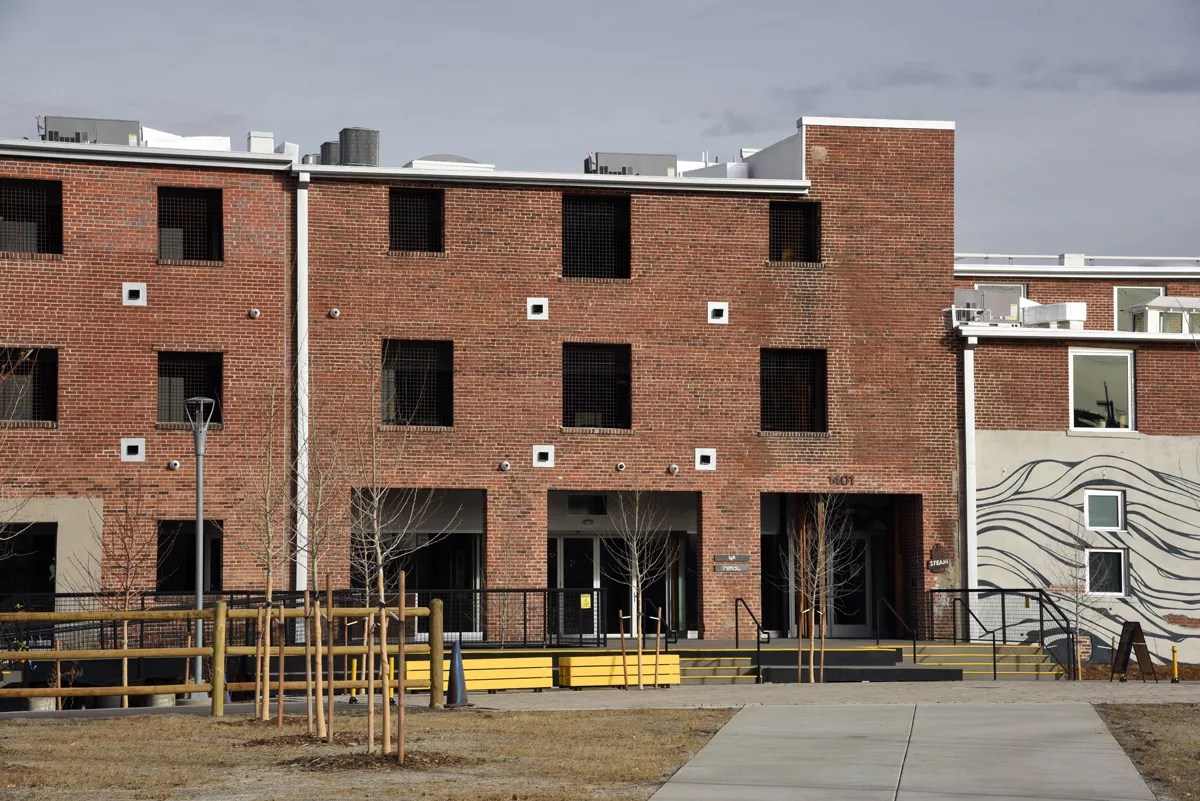
Steam on the Platte is the first big new project in the area.
Anthony Camera
Although residential projects are on the drawing board for Sun Valley, among the first new developments in the neighborhood was Steam on the Platte, located just down from the Meow Wolf site on Zuni Street between 14th and Lower Colfax avenues. It’s within walking distance of the Auraria campus and the Broncos stadium; it’s also at the intersection of the Lakewood Gulch and Platte River bike trails, and a short walk to light-rail stations at Decatur-Federal and West Auraria.
Urban Ventures and White Construction Group formed a partnership to acquire the property in 2014 from the estate of the late Arvin Weiss, who in 2008 was sentenced to seven years in federal prison after being convicted of fraud and witness tampering in a scheme to cheat mortgage companies that funded federally insured home loans. After being diagnosed with cancer, Weiss was released from prison in 2013; he died soon after.
“It really started with the city doing a station area plan around the Decatur station about five years ago,” says Susan Powers, president of Urban Ventures. “We knew that this was really the growth area from downtown, because it’s just the logical place. And for us, the river was really key. It’s unusual to find any property you can build right up to the river.”
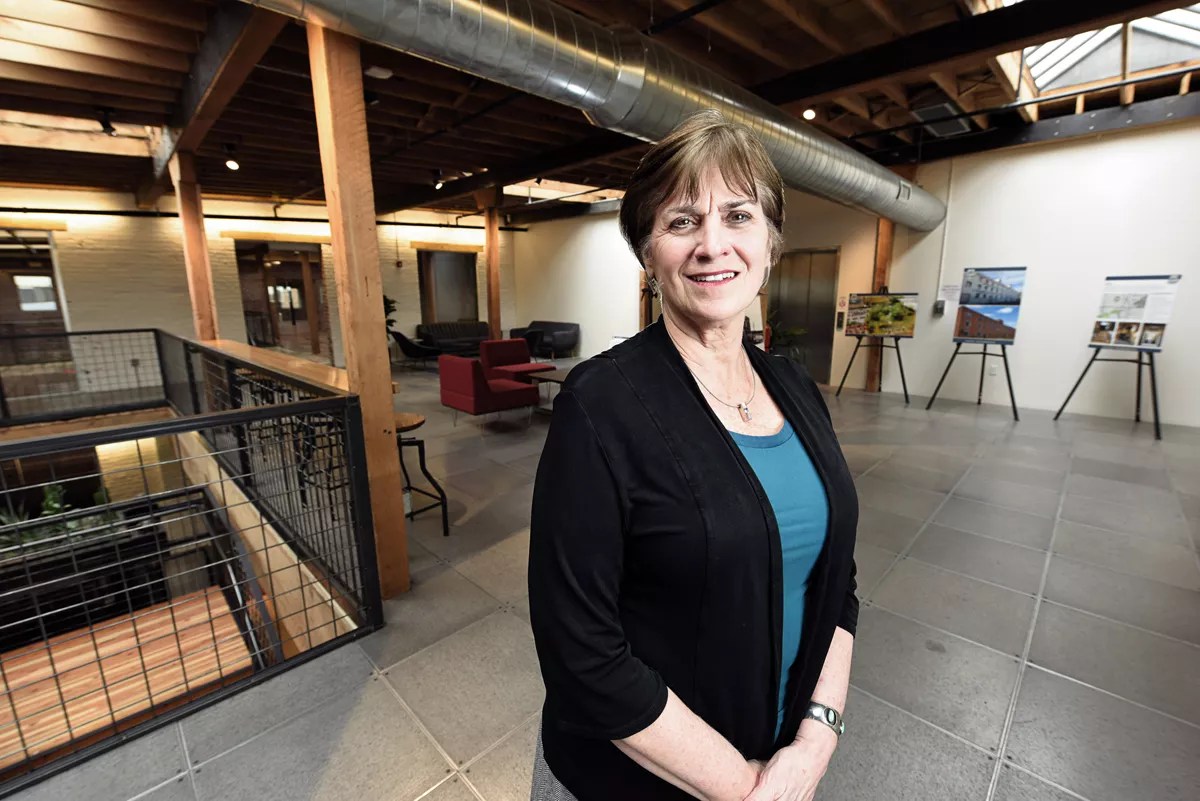
Susan Powers saw possibility in Sun Valley.
Anthony Camera
The Steam site had been home to a variety of industrial users dating back to the late 1800s, including the Johnson and Bremer Soap Factory, a rag-baling facility and a mikvah, or ceremonial bathhouse. Manufacturing continued there through the mid-1900s, but much of the property was abandoned more than thirty years ago. When Urban Ventures and White Construction purchased it, two illegal marijuana grows were operating there, and the Evil Souls motorcycle club had taken over part of one of the buildings on the site as its clubhouse.
The new owners wanted to create a mixed-use project that would attract office tenants, who started moving in late last year. NIMBL, a technology consulting company, relocated from the Art District on Santa Fe to 12,000 square feet on the main building’s second floor. Joining NIMBL is rideshare company Lyft, which has opened a driver hub in the building. Two Denver architecture firms also have moved into Steam: Olson Lavoie and Davis Wince.
In addition to 62,255 square feet of rentable space, the building also has several shared conference rooms, a yoga studio and a cafe that’s operated by Girls Inc., a national nonprofit that inspires girls to be strong, smart and bold. The building’s 24 original skylights have been restored, and one skylight has been added.
At full buildout, the entire site will hold 190,000 square feet of office space, as well as a 6,000-square-foot restaurant in another existing building with a bowstring roof fronting the river, and about 100 new residential units.
To the west of Steam, at 2705 West Colfax Avenue, Powers is working with Adrianna Abarca to redevelop four pastel-colored buildings owned by her family into the Latino Cultural Arts Center. Abarca, who grew up near Sun Valley, says the site was the former headquarters of Ready Foods, a custom food processor founded in 1972 by her late father, Luis. The collection of Mexican and Chicano art that she and her father spent decades accumulating will be permanently displayed at the center in the Mexican Heritage Museum.
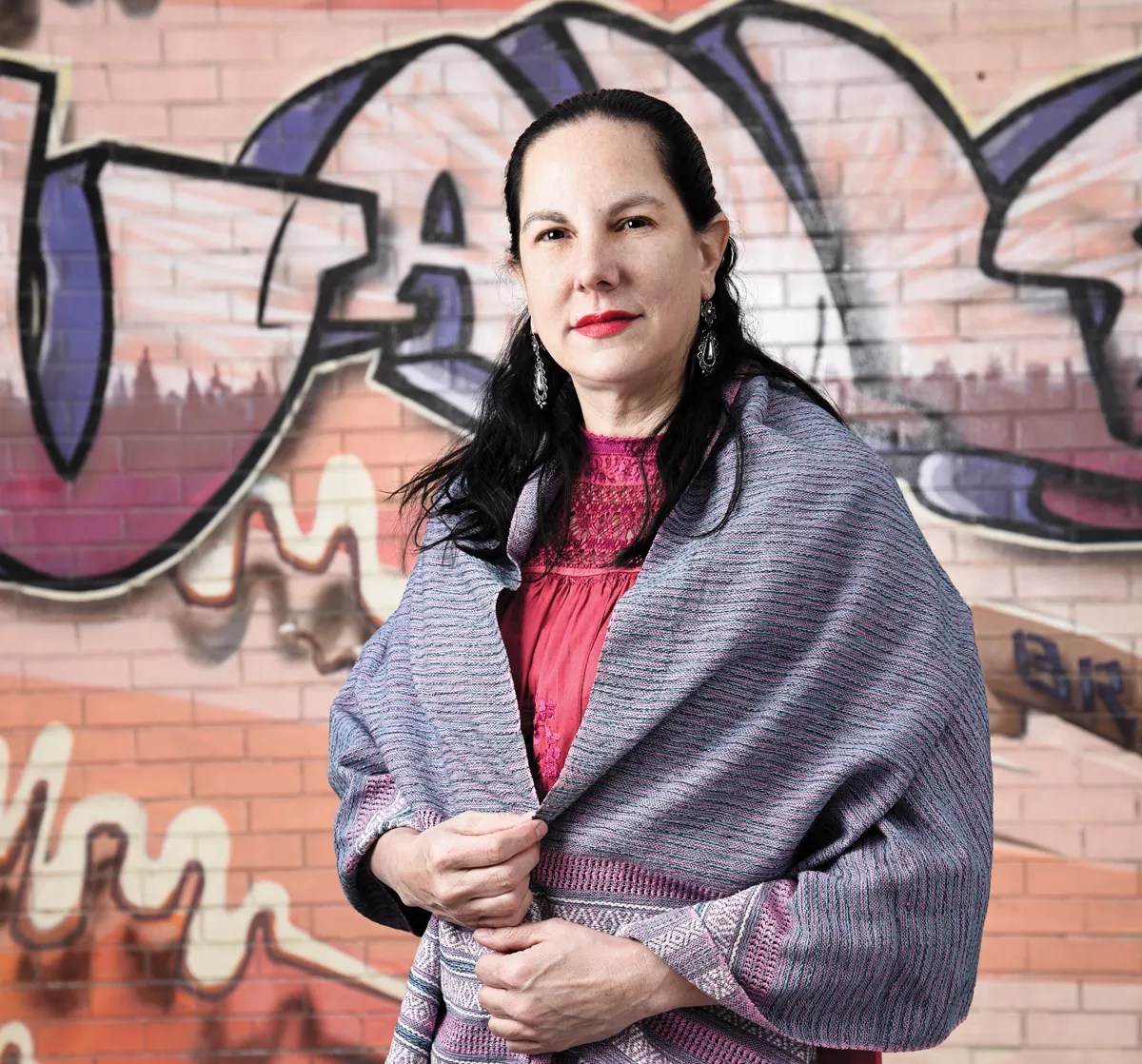
Adrianna Abarca wants to save Sun Valley’s Latino heritage.
Anthony Camera
“If I were to donate the collection to an institution, the bulk of it would end up in storage,” Abarca says. “The culture is so in-depth and full of life that it really needs to be shared, primarily with the Chicano and Mexican community, but I want everyone to experience the art. It gives people a real appreciation of what it is to be Mexican. Once you’ve been exposed to it, you realize how deep and rich your heritage is.”
In addition to a museum, the Latino Cultural Arts Center will include street-level retail, a coffee shop and cantina/cervecería, classrooms, a library, event space and a small auditorium. A second phase of the project, which will be housed in more Abarca-owned buildings at West Eighth Avenue and Decatur Street on the south end of Sun Valley, will add the Sun Valley Academy of Latino Cultural Arts, which will instruct students between the ages of 16 and 24 in performing, visual and culinary arts, as well as music and the spoken word. Under Abarca’s plan, there will be street-level retail and dormitory spaces for visiting artists.
Abarca, who no longer lives in the neighborhood, is excited by the opportunity to bring Lower Colfax back as the neighborhood’s main street and center for cultural activities. She says she expects to complete the project, which is being designed by Tania Salgado of Handprint Architects, within the next two years. “We’re ready to do what we need to do, but we don’t want to force anything,” she explains.
“These were our old stomping grounds, so it has even more importance to us,” Abarca says. “Because of gentrification, I want to make an effort to cement the Latino heritage in the community. It’s important not to feel like an outsider when your history is here.”
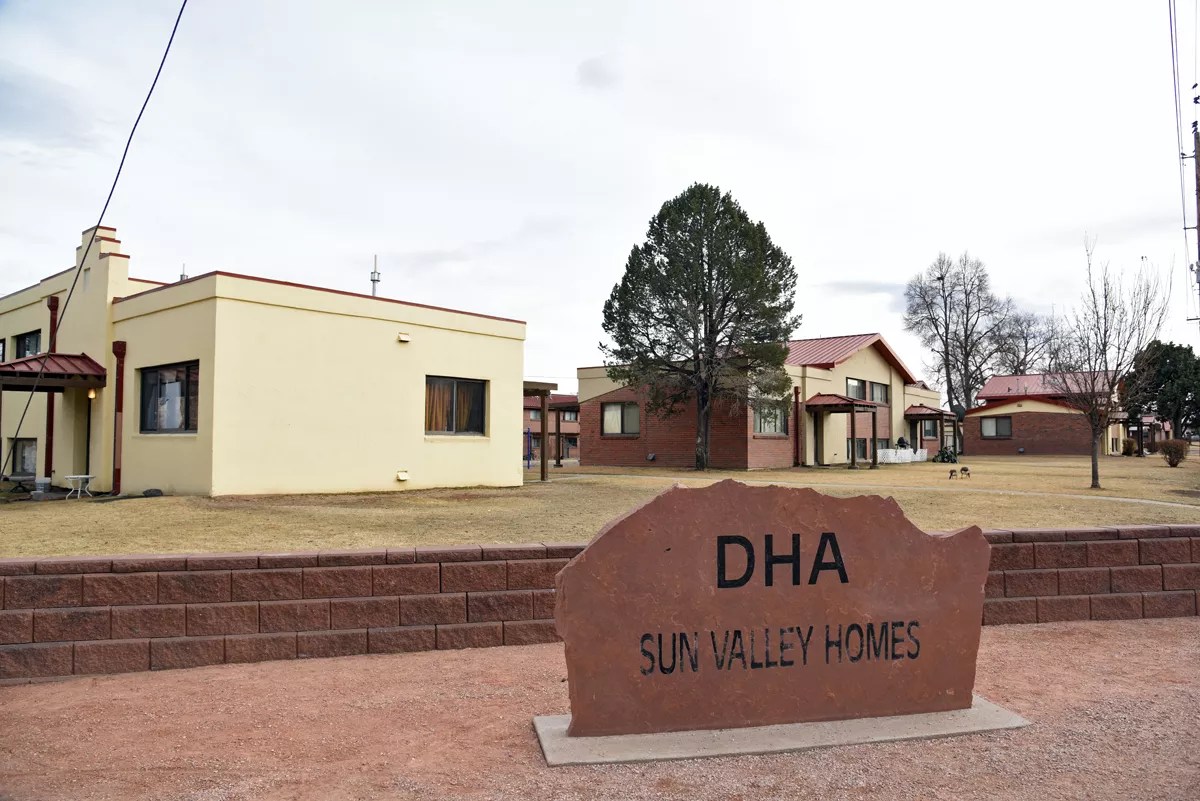
The Sun Valley Homes complex is slated for redevelopment.
Anthony Camera
Sun Valley isn’t likely to lose its rich Hispanic heritage any time soon, however. Latinos account for about 54 percent of Sun Valley’s 1,500 residents. And while the sixty-year-old Sun Valley Homes complex, located on 22 acres in the shadow of Mile High Stadium, is slated for redevelopment, the Denver Housing Authority‘s approach to the project was designed so that those residents won’t be displaced, even as the number of people living in the area doubles.
Last year the DHA received a $30 million Choice Neighborhood Implementation Grant from the U.S. Department of Housing and Urban Development, to help create a comprehensive community revitalization plan. The goal is to create up to 800 new housing units in a mixed-use, mixed-income neighborhood. Over the course of six phases of development, DHA’s $240 million project will replace both Sun Valley Homes and Sun Valley Annex’s 333 public-housing units, while also constructing 202 moderate-income housing units and 215 market-rate units.
There will be a mix of lower-density townhomes near the neighborhood’s elementary school and higher-density developments near the light-rail station. The plan also calls for a family/youth hub, open-space amenities and opportunities for local businesses. Infrastructure improvements, to be funded through a recently approved GO Bond, include the realignment of West 13th Avenue to improve mobility from Federal Boulevard to downtown. GO Bond funding will also put initial investment into a new riverside park in Sun Valley.
“This mix of housing, in conjunction with the de-concentrating of the low-income population, will help attract and create a more vibrant, healthy, economically diverse community while retaining opportunities for existing families to benefit from the planned revitalization,” says Stella Madrid, DHA’s intergovernmental and community affairs officer.
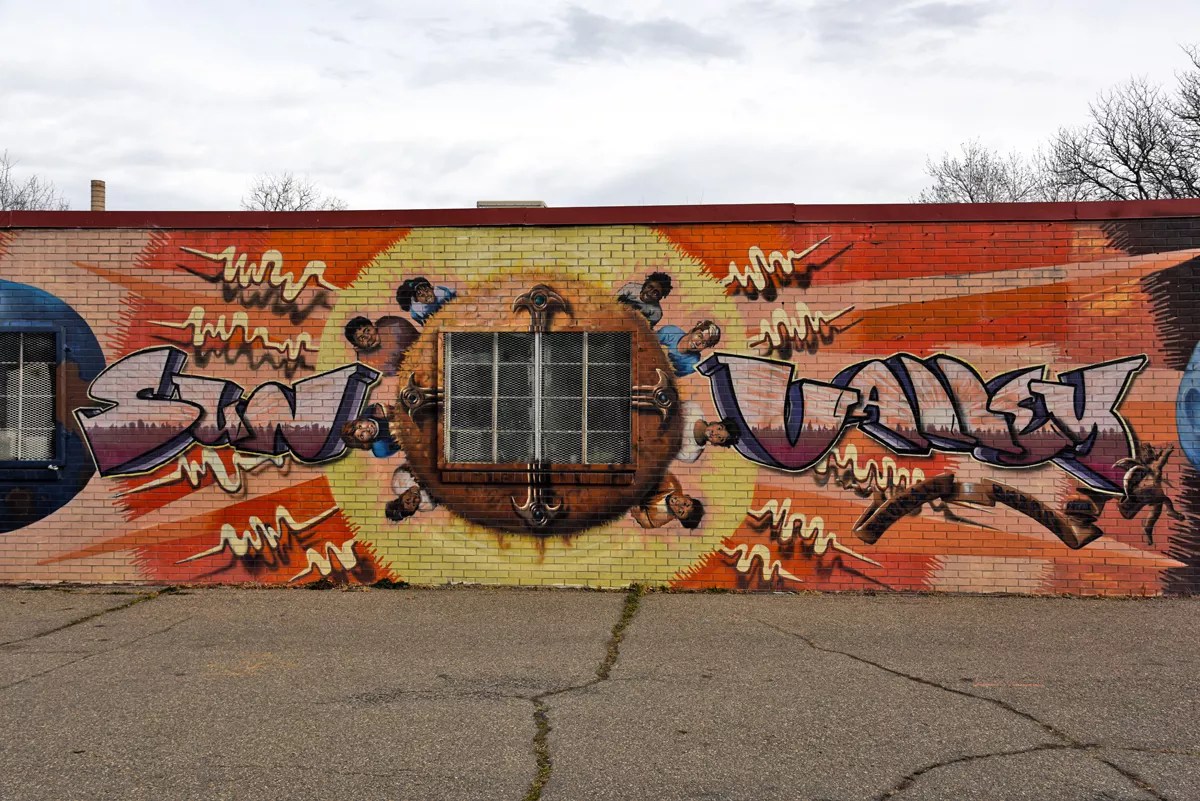
Sun Valley has a rich Latino heritage.
Anthony Camera
Other initiatives are coming from the newly created Sun Valley EcoDistrict (SVED), in which the city is a partner, which stretches from just north of Mile High Stadium south to Sixth Avenue. The SVED will serve as the developer for economic-development projects designed to connect residents to local employers and reuse blighted properties for job creation, flexible work spaces, a microbusiness incubator and an international food market in what’s largely a food desert; it will also provide loans to help launch new neighborhood-serving retail businesses.
The EcoDistrict is constructing a 30,000-square-foot, multi-use office building that will include community engagement space and offices for the SVED, the University of Denver and other professional for-profit and nonprofit entities; the building will also be part of an energy district designed to generate 30 percent of the energy needed in Sun Valley and to reduce water use by 20 percent. Once the energy system is in place, a performance-tracking and information center will inform residents and visitors of the district’s energy savings and usage. Free wi-fi access will help to connect residents to technology.
In addition to that new riverfront park, the EcoDistrict is planning community gardens and sports fields that will help address Sun Valley’s need for accessible open and recreational space.
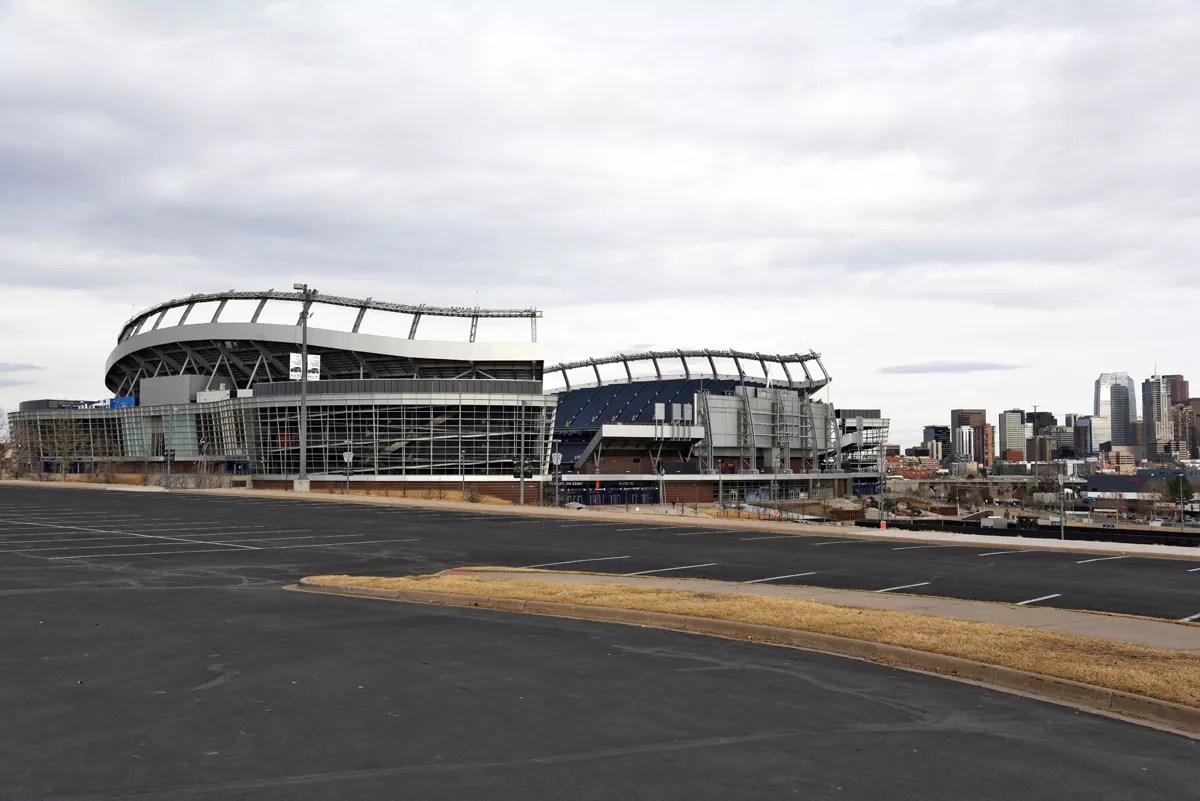
Mile High Stadium’s parking lots may be developed.
Anthony Camera
The area could soon have many other recreational opportunities. The vision for Sun Valley’s revitalization includes the Denver Broncos’ plan to build a $351 million entertainment district with retail, commercial and residential developments, though the Metropolitan Football Stadium District has characterized discussion of that plan as premature.
Still, there’s plenty to work with. Mile High sits on about 89 acres on the northern edge of Sun Valley. Much of that land – including the parcel that holds the 76,125-seat stadium, is owned by the stadium district, but the Denver Broncos’ real estate holdings include fourteen surface parking lots, mostly south of the stadium, totaling 7,500 parking spaces.
Although they’re not technically in Sun Valley, the parking lots for Elitch Gardens and the adjacent Pepsi Center also present a golden opportunity for redevelopment. Denver-based Kroenke Sports & Entertainment owns and operates the 18,007-seat Pepsi Center and the 45 acres surrounding it. Revesco Properties, in partnership with Second City Real Estate and Kroenke Sports & Entertainment, paid $140 million for Elitch’s in 2015; the site later chosen by Meow Wolf was part of that deal, and Revesco is a partner in that project.
Rhys Duggan, president and chief executive of Revesco, has declined to discuss any plans he might have for Elitch’s and its parking lots, but he does acknowledge that the vast amount of parking in Denver’s urban core is probably not the best use of the land. In fact, Denver emerged as the champion of Streetsblog USA’s 2017 Parking Madness tournament, largely because of the huge lots surrounding the Pepsi Center and Elitch’s.
“We were happy to receive the award for North America’s most egregious waste of urban downtown space taken up by a surface parking lot,” Duggan says. “Things are going to change. It doesn’t take a genius to know that.”
While those parking lots are big enough to meet Amazon’s demands for a possible second headquarters, any specific sites in Colorado’s pitch to the company are confidential…though Elitch’s is rumored to be one of the them.
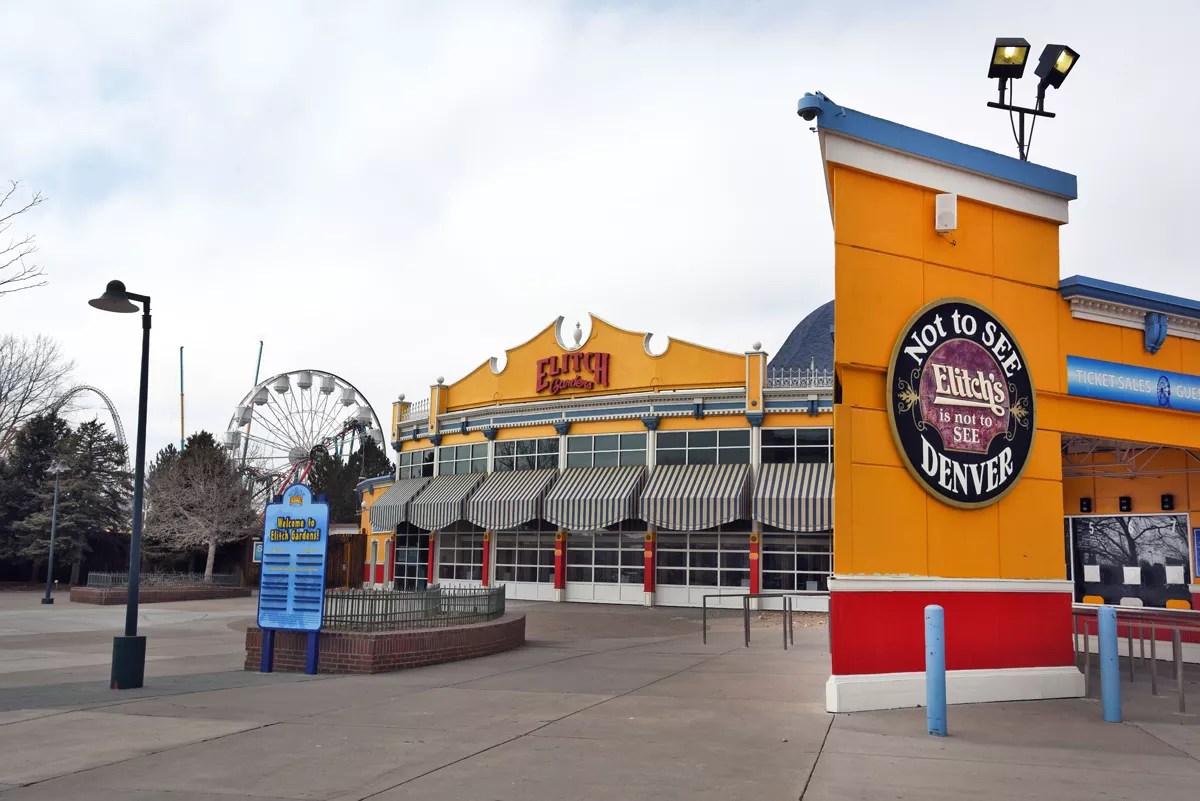
Elitch’s is in the midst of a sea of parking lots.
Anthony Camera
The city isn’t waiting to see what Amazon decides, and is taking a proactive approach to the anticipated development around Elitch’s and the Pepsi Center, according to Steve Nalley, neighborhood planning supervisor with the Denver Department of Community Planning and Development. The city is in the process of amending its circa 2007 Downtown Area Plan for the land between I-25, Auraria Parkway and Speer Boulevard; both Elitch’s and the Pepsi Center fall within those boundaries. Community Planning and Development plans to submit its recommendations to Denver City Council by the end of April.
The city’s Decatur Federal Station Area Plan notes that the nearby Auraria Higher Education Campus has a growing student population and little housing by the campus. The great multi-modal connections, access to downtown, recreation amenities, low lease rates and funky vibe could make the area around the Pepsi Center and Elitch’s ideal for student housing. “You see a bunch of parking lots and some big entertainment users like Pepsi Center, the amusement park, the Aquarium and the Children’s Museum in that area,” Nalley points out. “We’re exploring the potential of developing some of the parking lots. With the buildout of our city and the fact that we’re growing so quickly, we thought it was necessary to have a conversation with the community about what this would look like in the future.”
A key recommendation of the Downtown Area Plan was to attract more housing, mixed-use and pedestrian-friendly development to the area. But over the last decade, the city has not pursued redevelopment strategies or incentives around the light-rail stations. Then again, other areas near downtown, particularly RiNo and the blocks behind Union Station, have been the focus of an unanticipated boom over the past ten years.
Now it could be Sun Valley’s turn. “There’s an opportunity to make this feel like a new downtown neighborhood with density, a mix of uses and housing opportunities,” concludes Nally. “There are still these major entertainment uses, and parking is still very important, so there will still need to be a parking strategy. But we’re trying to be smarter about land.”